Safety Guidelines for Paddling Around Victoria & Vancouver Island
Victoria is the gateway to world class paddling destinations around Vancouver Island, BC. Being surrounded by water, Victoria offers an endless variety of paddle sport experiences from the serenity of a calm lake, or the bustle of an urban paddle on the inner harbour, to the excitement of a fast moving tidal current. Whether you’re a kayaker, kayak fisherman, canoeist, or standup paddle boarder (SUP), there is something here for everyone from novice to expert. And because of the area’s mild climate, there are paddling opportunities all year round!
If you choose to paddle in Victoria’s Harbour, please pay particular attention to the Rules & Regulations and the chart at the end of this post for specific information for paddling in the harbour.
Vancouver Island has approximately 3,500 kms (2,200 miles) of ocean coastline, over 700 lakes, and a myriad of rivers for paddling. All that, combined with spectacular West Coast scenery and a huge variety of wildlife and marine creatures, make Victoria a true paddler’s paradise.
Basic Paddle Sport Information You Should Know Before You Go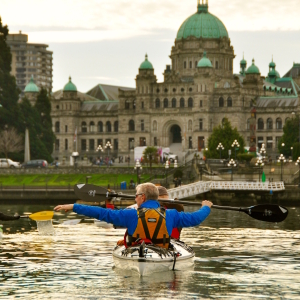
Transport Canada requires that paddlers carry certain safety items on human-powered pleasure craft such as canoes, kayaks, and stand up paddleboards (SUP). (Paddleboards aren’t mentioned by name by Transport Canada, but they are currently included in this category). The equipment you are required to carry varies by type and length of your craft, and where and when you’re paddling. You may need any or all of the following items. You can download the free Transport Canada Safety Guides below for more details.
Transport Canada Safe Boating Guide
Transport Canada Sea Kayaking Safety Guide
Basic Equipment You Are Required To Carry
This is a list of the basic equipment you are required to carry. Any rental from Ocean River Sports includes the mandatory safety gear. If you have any questions or require any of these items, don’t hesitate to consult our staff.
PFD
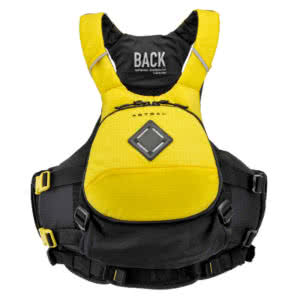 Every paddle craft is required to have one PFD (personal flotation device) or lifejacket for each person on board. If you prefer inflatable PFDs or belt packs, which are popular with standup paddle boarders because of their lack of bulk, you must be wearing them to be legal. Because they are not inherently bouyant, inflatables are not legal for whitewater. See our post How to Choose a PFD
Every paddle craft is required to have one PFD (personal flotation device) or lifejacket for each person on board. If you prefer inflatable PFDs or belt packs, which are popular with standup paddle boarders because of their lack of bulk, you must be wearing them to be legal. Because they are not inherently bouyant, inflatables are not legal for whitewater. See our post How to Choose a PFD
Visual Signaling Devices
- Flashlight You are required to carry a watertight flashlight if you are going to paddle in darkness, or low visibility conditions such as fog. If your boat is more than 6m (19.5’) long (like many double kayaks and tripping canoes) you are required to carry a watertight flashlight at all times. If you plan on paddling at night, especially in Victoria’s harbour, consider a steady burning white light that is visible from all sides. It will give other boaters a much better chance of seeing you.
- Flares If your craft is over 6m (19.5’), you’ are required to carry “Six Canadian-approved flares of Type A (Rocket Parachute), B (Multi-Star) or C (Hand).” You’re exempt if you’re paddling on a river, canal, or lake where you can’t get more than 1.852 km (one nautical mile) from shore, or if your boat “has no sleeping quarters or is engaged in an official competition or in final preparation for an official competition.” Whatever the regulations, if you are going to be paddling on the ocean around Victoria, it is a good idea to carry at least 3 handheld flares in a pocket on your PFD, they could save your life.
Sound Signalling Device
Every paddlecraft must have “one sound-signalling device or appliance that meets the applicable standards set out in the Collision Regulations.” A whistle fulfills this requirement. Make sure it is a ‘pealess’ model that will still function when wet, and it should be attached it to your PFD so it is with you and accessible at all times.
Heaving Line
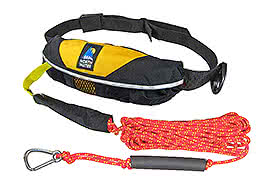 Almost every paddle craft is required to have “one buoyant heaving line at least 15 meters (49.3’) long.” Sit-on-top kayaks and stand up paddle boards are exempt, provided everyone is wearing an approved PFD or lifejacket. If you are paddling this type of craft it is strongly recommended that you wear a leash to prevent separation from your craft.
Almost every paddle craft is required to have “one buoyant heaving line at least 15 meters (49.3’) long.” Sit-on-top kayaks and stand up paddle boards are exempt, provided everyone is wearing an approved PFD or lifejacket. If you are paddling this type of craft it is strongly recommended that you wear a leash to prevent separation from your craft.
Note: A throwline will be of limited use for most paddlers. Whitewater paddlers can make good use of them from the shore, but a combination throwline/towline is a more practical option for sea kayakers and canoeists.
Bailer or Pump
“One bailer or manual bilge pump or bilge-pumping arrangements.” A bailer or manual bilge pump is not required for a boat that cannot hold enough water to make it capsize or a boat that has watertight compartments that are sealed and not readily accessible. Therefore, paddleboards, self-bailing inflatable kayaks, and sit-on-top kayaks with hatch-free flotation compartments are exempt. A pump is a much better bailing device than a scoop or bucket, particularly for kayaks as they are much faster and more practical for use in a small cockpit.
Reboarding Device
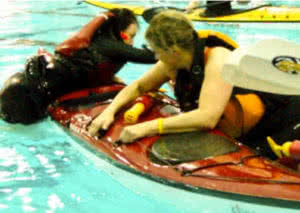 “One reboarding device.” This is required if the vertical height that must be climbed to reboard a boat is more than 0.5m (1.64′), so most paddle craft are exempt. For kayakers who are paddling open water, you should carry a rescue stirrup. Kayaks can be difficult to reenter from the low position you will be relative to your boat, so a stirrup can be a great asset for solo or assisted rescues, particularly if you lack upper body strength and/or are not very agile or have become weakened from the cold. (Rescues should always be practiced so you will know what to expect and what to do in an actual rescue situation). Talk to our Adventure Center staff about Rescue Courses.
“One reboarding device.” This is required if the vertical height that must be climbed to reboard a boat is more than 0.5m (1.64′), so most paddle craft are exempt. For kayakers who are paddling open water, you should carry a rescue stirrup. Kayaks can be difficult to reenter from the low position you will be relative to your boat, so a stirrup can be a great asset for solo or assisted rescues, particularly if you lack upper body strength and/or are not very agile or have become weakened from the cold. (Rescues should always be practiced so you will know what to expect and what to do in an actual rescue situation). Talk to our Adventure Center staff about Rescue Courses.
Compass
If your boat is 8m (26′) or less in length and you are paddling within sight of navigation markers you are not required to carry a compass. However, fog is a regular occurrence around Victoria, particularly in the late summer, so a compass and chart are always excellent tools to have on hand. We always recommend a chart and compass. GPS’s can be very useful tools as well, but should never replace a good compass and chart. Unsure of how to use a compass and chart and want to learn, check out our Navigation Courses.
Electronic Communication Devices
While there are no regulations requiring you to carry any form of electronic communication device while paddling, if you plan to paddle offshore, you should consider carrying one of these devices with you. They should be carried on your person in case you get separated from your boat. The level of sophistication, their small size and affordability of modern emergency communication devices really leave no excuse for not doing so. If you do find yourself in a life-threatening situation the ability to call for help and perhaps knowing that your distress call has been received, is priceless and may save yours or someone else’s life.
VHF marine radios, cell phones (always in a waterproof case), and satellite devices add a whole new level of safety for paddlers on the water and off. If you are serious about your safety on the water you should consider carrying at least one of these devices with you. However, before you run out and buy one, have a look at the advantages and limitations of each type of device.
Check out out our blog post for more information on communication devices: Emergency Communication Devices for Paddlers.
Safety Considerations
Cold water
The ocean surrounding Victoria is very, cold ranging from winter lows of 8ºC or 43.5ºF to highs of 12ºC or 53.5ºF in the summer months. So care should be taken when planning to paddle here.
- Most people who are unaccustomed to cold water will experience cold shock response somewhere between 10-15ºC or 50-60ºF. This means that an unprotected immersion will cause most people to completely lose control of their breathing – they will be gasping and hyperventilating as hard and fast as they can. This can lead to inhalation of water and drowning.
- Cold water robs the body’s heat 32 times faster than cold air. As well, physical exercise such as swimming or just struggling to keep your head out of the water will cause the body to lose heat at a much faster rate than remaining still in the water.
 Therefore, you should always follow the rules of cold-water safety:
Therefore, you should always follow the rules of cold-water safety:
- Always wear your PFD – you will not be able to put it on once your are in the water.
- Always dress for the water temperature. Wetsuits and drysuits and layers of clothing.
- Field test your gear & practice your rescues. Make sure you know how to get back into or back on your paddle craft.
- Be prepared, plan for the worst that can happen. Carry the necessary safety gear including pumps, rescue stirrups, flares, whistles, and communication devices.
Weather
Unless you are just heading out to the lake or planning to paddle the sheltered waters of the Inner Harbour, you should always check the weather before you set out on the ocean. Particularly the wind forecast, its strength and direction. The following websites are excellent sources for this data.
Tides and Currents
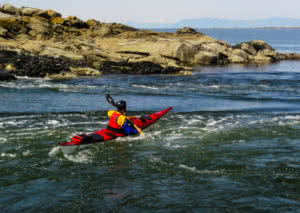 The waters around Victoria and Southern Vancouver Island are known for their strong currents. Any of the channels between offshore islands or islets and Vancouver Island can form very strong current flows and tide rips (standing waves). Any current over 2 nautical miles per hour is considered strong and is cause for concern for unwary paddlers. As well, wind against current can create larger and steeper waves so conditions in channels can change rapidly. Always check the current tables and the wind forecast before setting out. If in doubt, check with our staff at Ocean River Sports Adventure Centre. They will be glad to help you out.
The waters around Victoria and Southern Vancouver Island are known for their strong currents. Any of the channels between offshore islands or islets and Vancouver Island can form very strong current flows and tide rips (standing waves). Any current over 2 nautical miles per hour is considered strong and is cause for concern for unwary paddlers. As well, wind against current can create larger and steeper waves so conditions in channels can change rapidly. Always check the current tables and the wind forecast before setting out. If in doubt, check with our staff at Ocean River Sports Adventure Centre. They will be glad to help you out.
Don’t get confused between tides and currents. Tides are the vertical rise and fall of ocean water levels, currents are the inward and outward horizontal flow of water creating water movement like a river. Tide tables cannot be used to predict currents so make sure you are using current tables.
Here is the link to Environment Canada’s online Tide and Current Tables. Canadian Tide and Current Tables
Another excellent resource for checking tides is this excellent phone App for your phone. Ayetides
If you want to learn more about understanding weather forecasts, tides and currents, how to read the tide & current tables and learning how to paddle in tidal currents, check out our course offerings at the Adventure Center.
Special Guidelines for Paddling in Victoria Harbour
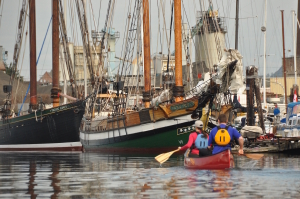 Victoria has one of the most beautiful harbours and inland waterways in the world, making it a spectacular – as well as an incredibly convenient spot to go paddling for a few hours or a day. Exploring this historic working harbour from the water, with its historic streets and architecture as well as it’s rich mix of ongoing activities including; whale watching cruises, international ferries, commercial tugs, float planes, cruise ships, recreational power and sail boats, fishing boats, ship repair facilities, water taxi’s, and of course, all kinds of paddle craft, can be incredibly rewarding.
Victoria has one of the most beautiful harbours and inland waterways in the world, making it a spectacular – as well as an incredibly convenient spot to go paddling for a few hours or a day. Exploring this historic working harbour from the water, with its historic streets and architecture as well as it’s rich mix of ongoing activities including; whale watching cruises, international ferries, commercial tugs, float planes, cruise ships, recreational power and sail boats, fishing boats, ship repair facilities, water taxi’s, and of course, all kinds of paddle craft, can be incredibly rewarding.
The Port of Victoria is a very busy working harbour with lots of aviation and marine traffic and it is classified as a Water Airport. Therefore, it is essential that you follow the rules and regulations for operating a paddle craft in the harbour, particularly paying attention to the areas designated as seaplane landing and takeoff areas. The harbour is patrolled and you can by charged and/or fined for not obeying the rules. Click the following link for a complete list of the special procedures and restrictions that apply to all vessels (including paddle craft) and seaplanes operating in the Port of Victoria: Harbour Rules and Regulations. If in doubt, talk to the staff at the Adventure Center, they will be happy to supply you with a map of the harbour. If you’re still in doubt, consider taking one of our very popular Harbour Tours.
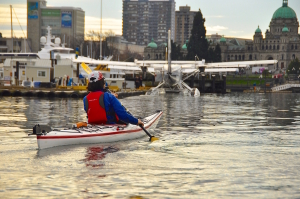
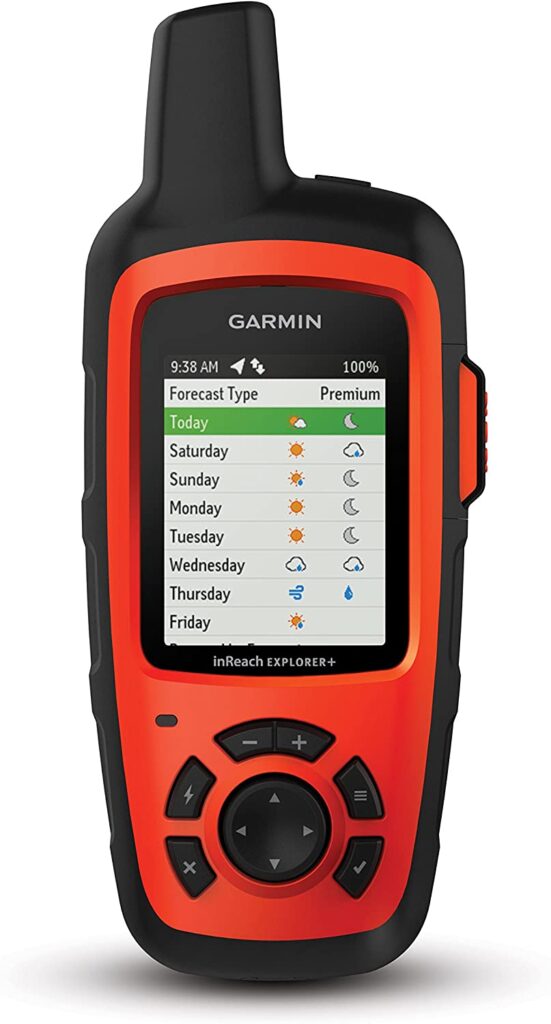
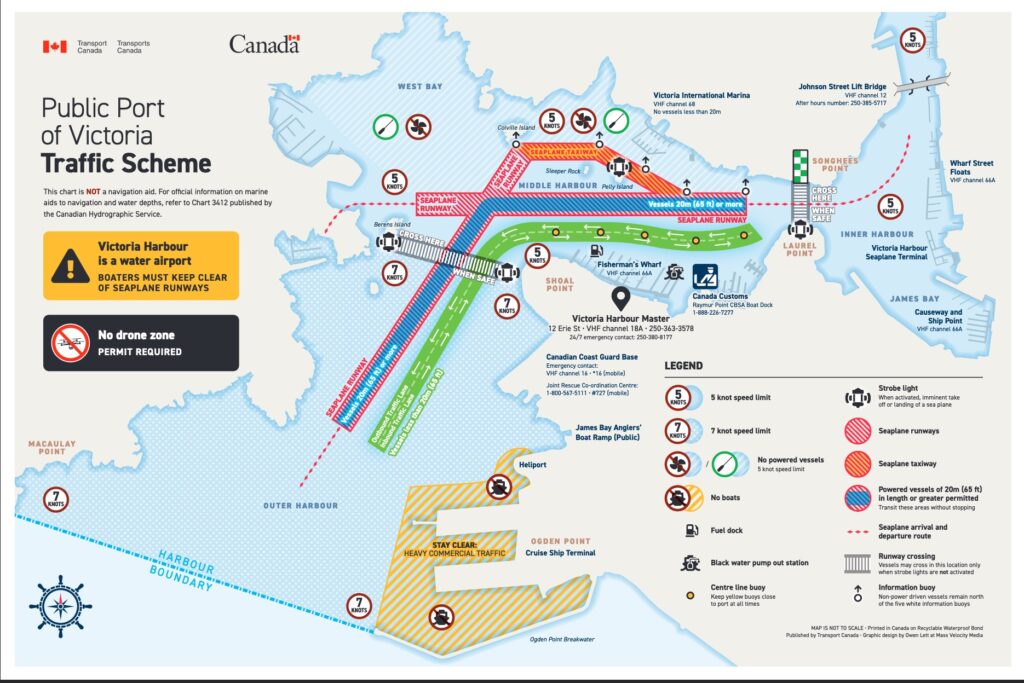


Great article! And a reminder that Victoria is such a beautiful place to Kayak!
This is really helpful! A great article, thank you for sharing!